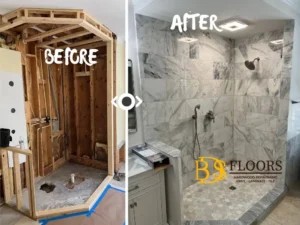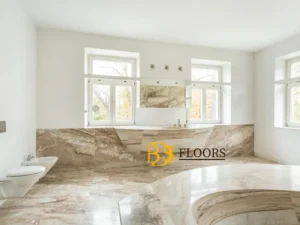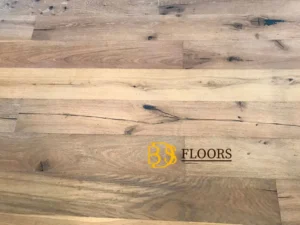Might prefinished hardwood flooring be a suitable option for improving your home? Knowing the distinctions between prefinished and conventional hardwood floors can assist you in making an informed decision.
Although hardwood floors can provide a natural and cozy atmosphere to any space, the traditional installation process is time-intensive, messy, and exposes the installer to harmful fumes from stains and sealants. Consequently, even skilled DIYers may choose to hire a professional. Prefinished hardwood flooring, on the other hand, offers a simpler option for achieving the elegance of real wood flooring, as it is sold with pre-applied stain and sealant. Nevertheless, like any flooring material, prefinished hardwood has its pros and cons. Before making a decision on whether it’s the right choice for your home, continue reading to discover its advantages and disadvantages.
Prefinished wood flooring offers a more durable finish than traditional hardwood flooring.
When comparing prefinished hardwood flooring to traditional unfinished hardwood, one of the most significant differences is the durability of the finish. Prefinished hardwood planks are treated with a highly robust aluminum oxide crystal sealant during production, making them ideal for heavy foot traffic and other forms of wear and tear. In contrast, conventional hardwood floors are installed first and then stained and sealed. As neither DIYers nor flooring contractors can access manufacturer-grade sealants, traditional hardwood floors are not as durable as their prefinished counterparts, and can start showing signs of scratches and surface dulling in as little as 5 to 7 years. With superior chemical sealers, prefinished flooring can maintain its pristine appearance for up to 25 years without dulling or wearing thin.
With prefinished hardwood flooring, there are fewer design options available compared to traditional hardwood floors. When selecting traditional hardwood flooring, you can choose from a vast selection of wood species and various stain and sealant options, enabling you to achieve your desired wood grain look, color, and surface finish. In contrast, prefinished hardwood flooring comes in a limited range of wood types, such as maple and red oak, and a restricted choice of colors and sealants.
One advantage of prefinished wood flooring is its fast installation process. Homeowners who choose prefinished wood flooring can enjoy a quick and straightforward installation process, especially if they opt for a DIY installation. Online resources can easily guide you on how to install prefinished hardwood flooring, making it an ideal choice for people staying in their homes during renovation. Traditional hardwood floor installation, on the other hand, can take two weeks or more, involving several phases like plank installation, sanding, staining, and applying multiple coats of sealant that take days to cure. Besides being lengthy, the process can also be messy and produce toxic fumes. In contrast, prefinished flooring provides a seamless installation process, allowing you to walk on the floor and arrange furniture as soon as the planks are installed, with no downtime required.
Subfloor irregularities can show through prefinished hardwood floors.
Prefinished hardwood floors can show subfloor irregularities if the subfloor has dips or heaves. If installed on a level subfloor, prefinished hardwood flooring will look as smooth as traditional hardwood flooring. However, unlike traditional hardwood flooring that can be sanded to remove lippage or slight inconsistencies in floor level, prefinished planks cannot be sanded since they are already finished. Uneven spots in the subfloor may cause some planks to raise slightly or create visible gaps between them, which could be noticeable, particularly if the subfloor is seriously uneven. Although the effect may not be significant, subfloor irregularities could still cause prefinished hardwood floors to look less polished.
Prefinished hardwood flooring has visible seams due to bevels along the top edges of each plank, known as cambers, that create a shallow “V” groove at every seam when two planks are installed side by side. Although the bevels are small, they create visible lines that some people may like while others may prefer the flush look of traditionally finished hardwood flooring that has been sanded smooth. Additionally, the grooves can serve as a spot for dust and debris to collect, making prefinished floors slightly more difficult to clean.
Prefinished hardwood planks can be refinished, just as traditional planks can.
Prefinished hardwood planks are capable of being refinished just like traditional planks.
Although prefinished hardwood flooring can maintain its beauty for many years, if you ever want to alter the finish of your planks, you can. Pre-finished hardwood flooring is genuine wood flooring, which means the surface can be sanded down and refinished with a new stain and sealer, just like traditional hardwood flooring. However, sanding the finish of pre-finished wood flooring may take a little longer than traditional wood floors because the sealant is tougher.
The cost of prefinished hardwood flooring, including installation, is comparable to that of traditional hardwood flooring.
Although the cost of installation for prefinished hardwood floors is significantly less than that of traditional hardwood floors, the prefinished planks themselves are typically more expensive than unfinished wood planks. You will most likely spend the amount you save in labor on the higher cost of prefinished planks, which can range from $5 to $10 per square foot, depending on the wood type and finish quality. Expect to pay this amount to have prefinished wood flooring professionally installed.
Installing prefinished hardwood planks is easier to DIY.
Prefinished hardwood flooring is a much simpler DIY installation process compared to traditional hardwood flooring. Although you still need to nail each plank individually to the subfloor, there is no need for sanding, staining or sealing, which can be a messy and time-consuming process. Furthermore, you don’t have to worry about harmful fumes from stains and sealants. DIY installation of prefinished hardwood flooring can save you between $2 and $5 per square foot compared to professional installation.
Prefinished hardwood plank flooring requires less ongoing maintenance than finished hardwood flooring.
Prefinished hardwood plank flooring needs less upkeep than hardwood flooring finished on-site. The finish that is applied in the factory is typically more long-lasting than the finish that is applied on-site. This means that you may not need to sand and refinish your prefinished hardwood flooring for up to 25 years, whereas hardwood flooring finished on-site usually requires resurfacing every 5 years. While the “grooves” in prefinished flooring may require a bit more effort to clean, they can be swept or vacuumed along with the surface of the floor.
If you’re considering prefinished hardwood flooring for your home, there are some important factors to keep in mind. First, be aware that engineered hardwood is not the same as prefinished hardwood; engineered hardwood is a type of laminate flooring with a thin layer of hardwood on the surface, and it cannot be refinished like real hardwood. Additionally, narrow prefinished hardwood planks can take longer to install than wider planks, which can increase the cost of labor if you’re hiring a professional. The most common prefinished hardwood plank sizes range from 3 inches to 4.75 inches, which offer a timeless look that complements many home styles. By considering these factors, you can make an informed decision when choosing the right prefinished hardwood for your flooring project.
Prefinished hardwood planks wider than 4¾ inches are often preferred for their rustic country style, but they can also make a room appear smaller. Therefore, they are best suited for larger, spacious rooms. It’s also important to consider the amount of foot traffic the room will experience when selecting a wood species. The Janka scale rates the hardness of hardwood, with higher numbers indicating harder wood. Red oak, with a Janka rating of around 1,290, is a popular flooring species. However, if you have kids or pets who are active, you may want to choose a harder wood species such as white oak, which has a Janka rating of 1,360.
Final Thoughts
Before deciding on prefinished hardwood flooring for your home, consider these three important questions.
Firstly, how much time do you have? If you don’t have the time or patience to wait for the in-place finishing process, prefinished hardwood might be the better option for you.
Secondly, do you prefer the flat, unbeveled look of traditional hardwood flooring? If so, then prefinished flooring may not be the best choice, as it typically has a bevel along the top edges.
Lastly, how much care and maintenance are you willing to provide for your floors? Prefinished hardwood flooring generally requires less maintenance, as the factory-applied sealants tend to be more durable than those applied on-site.
Looking for more information on prefinished hardwood floors? Here are answers to some frequently asked questions that may help you make a decision.
Q: What is the lifespan of prefinished hardwood floors? A: Prefinished and unfinished hardwood floors are known for their durability and can last a lifetime. The factory finish on prefinished flooring can remain intact for up to 25 years before requiring a refresh.
Q: Can prefinished floors be sanded and refinished? A: Yes, prefinished hardwood floors can be sanded and refinished, although the process can be more difficult due to the strong factory-applied coatings. Once the old finish is removed, a new one can be applied.
Q: Is it necessary to seal prefinished hardwood floors? A: Most prefinished hardwood floors come fully sealed from the manufacturer and don’t require additional sealing. Adding extra sealant may actually harm the factory-applied protectants. However, it’s a good idea to review the manufacturer’s instructions for your specific flooring to determine whether additional sealant is necessary or recommended.







